tire size CADILLAC ESCALADE 2010 3.G User Guide
[x] Cancel search | Manufacturer: CADILLAC, Model Year: 2010, Model line: ESCALADE, Model: CADILLAC ESCALADE 2010 3.GPages: 616, PDF Size: 39.41 MB
Page 513 of 616
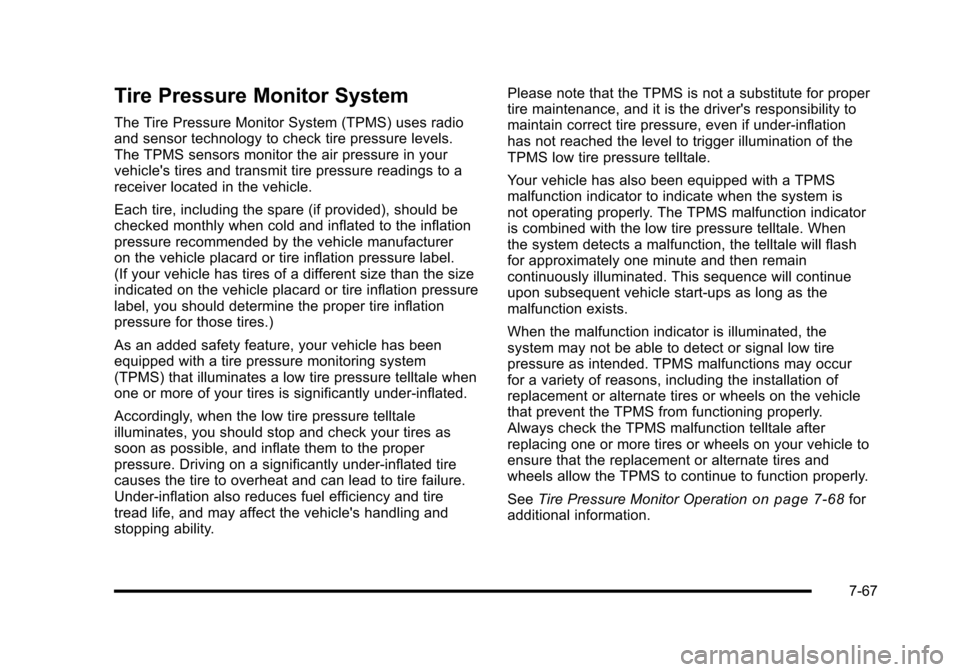
Tire Pressure Monitor System
The Tire Pressure Monitor System (TPMS) uses radioand sensor technology to check tire pressure levels.The TPMS sensors monitor the air pressure in yourvehicle's tires and transmit tire pressure readings to areceiver located in the vehicle.
Each tire, including the spare (if provided), should bechecked monthly when cold and inflated to the inflationpressure recommended by the vehicle manufactureron the vehicle placard or tire inflation pressure label.(If your vehicle has tires of a different size than the sizeindicated on the vehicle placard or tire inflation pressurelabel, you should determine the proper tire inflationpressure for those tires.)
As an added safety feature, your vehicle has beenequipped with a tire pressure monitoring system(TPMS) that illuminates a low tire pressure telltale whenone or more of your tires is significantly under!inflated.
Accordingly, when the low tire pressure telltaleilluminates, you should stop and check your tires assoon as possible, and inflate them to the properpressure. Driving on a significantly under!inflated tirecauses the tire to overheat and can lead to tire failure.Under!inflation also reduces fuel efficiency and tiretread life, and may affect the vehicle's handling andstopping ability.
Please note that the TPMS is not a substitute for propertire maintenance, and it is the driver's responsibility tomaintain correct tire pressure, even if under!inflationhas not reached the level to trigger illumination of theTPMS low tire pressure telltale.
Your vehicle has also been equipped with a TPMSmalfunction indicator to indicate when the system isnot operating properly. The TPMS malfunction indicatoris combined with the low tire pressure telltale. Whenthe system detects a malfunction, the telltale will flashfor approximately one minute and then remaincontinuously illuminated. This sequence will continueupon subsequent vehicle start!ups as long as themalfunction exists.
When the malfunction indicator is illuminated, thesystem may not be able to detect or signal low tirepressure as intended. TPMS malfunctions may occurfor a variety of reasons, including the installation ofreplacement or alternate tires or wheels on the vehiclethat prevent the TPMS from functioning properly.Always check the TPMS malfunction telltale afterreplacing one or more tires or wheels on your vehicle toensure that the replacement or alternate tires andwheels allow the TPMS to continue to function properly.
SeeTire Pressure Monitor Operationon page 7!68foradditional information.
7-67
Page 514 of 616
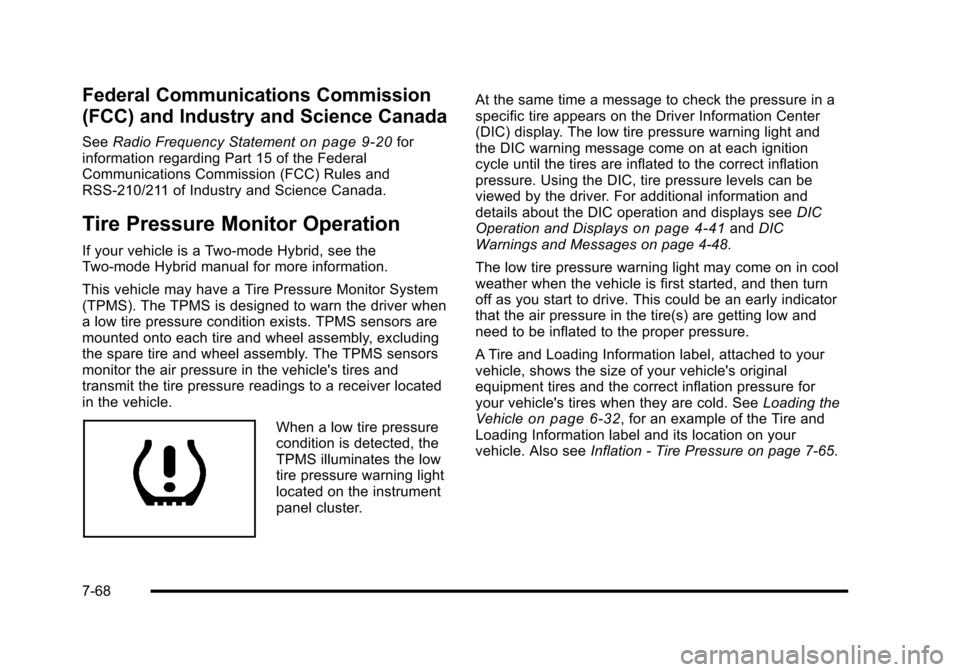
Federal Communications Commission
(FCC) and Industry and Science Canada
SeeRadio Frequency Statementon page 9!20forinformation regarding Part 15 of the FederalCommunications Commission (FCC) Rules andRSS-210/211 of Industry and Science Canada.
Tire Pressure Monitor Operation
If your vehicle is a Two!mode Hybrid, see theTwo!mode Hybrid manual for more information.
This vehicle may have a Tire Pressure Monitor System(TPMS). The TPMS is designed to warn the driver whena low tire pressure condition exists. TPMS sensors aremounted onto each tire and wheel assembly, excludingthe spare tire and wheel assembly. The TPMS sensorsmonitor the air pressure in the vehicle's tires andtransmit the tire pressure readings to a receiver locatedin the vehicle.
When a low tire pressurecondition is detected, theTPMS illuminates the lowtire pressure warning lightlocated on the instrumentpanel cluster.
At the same time a message to check the pressure in aspecific tire appears on the Driver Information Center(DIC) display. The low tire pressure warning light andthe DIC warning message come on at each ignitioncycle until the tires are inflated to the correct inflationpressure. Using the DIC, tire pressure levels can beviewed by the driver. For additional information anddetails about the DIC operation and displays seeDICOperation and Displayson page 4!41andDICWarnings and Messages on page 4!48.
The low tire pressure warning light may come on in coolweather when the vehicle is first started, and then turnoff as you start to drive. This could be an early indicatorthat the air pressure in the tire(s) are getting low andneed to be inflated to the proper pressure.
A Tire and Loading Information label, attached to yourvehicle, shows the size of your vehicle's originalequipment tires and the correct inflation pressure foryour vehicle's tires when they are cold. SeeLoading theVehicleon page 6!32, for an example of the Tire andLoading Information label and its location on yourvehicle. Also seeInflation - Tire Pressure on page 7!65.
7-68
Page 519 of 616
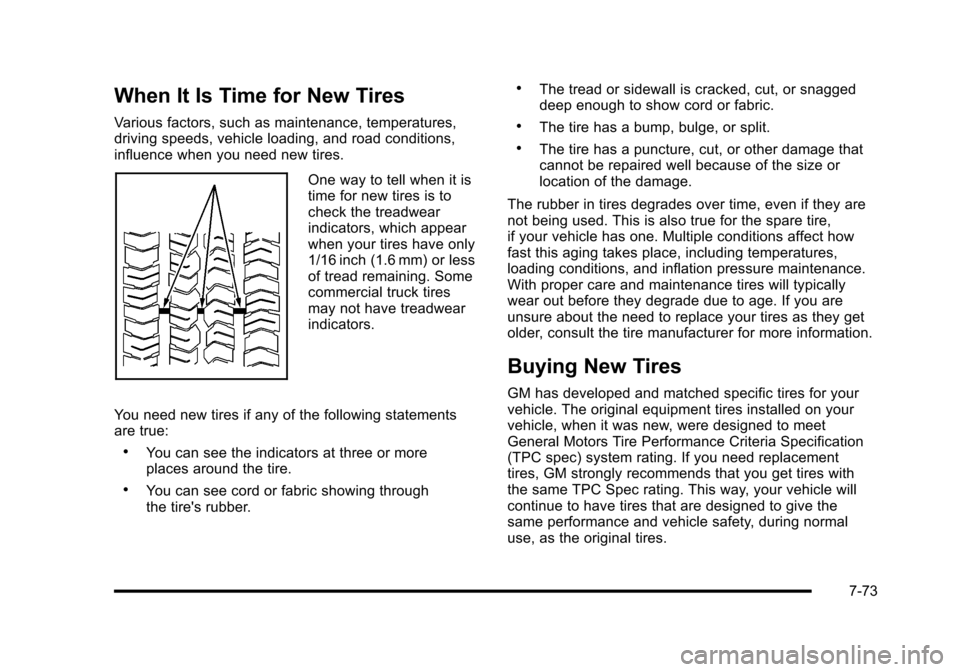
When It Is Time for New Tires
Various factors, such as maintenance, temperatures,driving speeds, vehicle loading, and road conditions,influence when you need new tires.
One way to tell when it istime for new tires is tocheck the treadwearindicators, which appearwhen your tires have only1/16 inch (1.6 mm) or lessof tread remaining. Somecommercial truck tiresmay not have treadwearindicators.
You need new tires if any of the following statementsare true:
.You can see the indicators at three or moreplaces around the tire.
.You can see cord or fabric showing throughthe tire's rubber.
.The tread or sidewall is cracked, cut, or snaggeddeep enough to show cord or fabric.
.The tire has a bump, bulge, or split.
.The tire has a puncture, cut, or other damage thatcannot be repaired well because of the size orlocation of the damage.
The rubber in tires degrades over time, even if they arenot being used. This is also true for the spare tire,if your vehicle has one. Multiple conditions affect howfast this aging takes place, including temperatures,loading conditions, and inflation pressure maintenance.With proper care and maintenance tires will typicallywear out before they degrade due to age. If you areunsure about the need to replace your tires as they getolder, consult the tire manufacturer for more information.
Buying New Tires
GM has developed and matched specific tires for yourvehicle. The original equipment tires installed on yourvehicle, when it was new, were designed to meetGeneral Motors Tire Performance Criteria Specification(TPC spec) system rating. If you need replacementtires, GM strongly recommends that you get tires withthe same TPC Spec rating. This way, your vehicle willcontinue to have tires that are designed to give thesame performance and vehicle safety, during normaluse, as the original tires.
7-73
Page 520 of 616
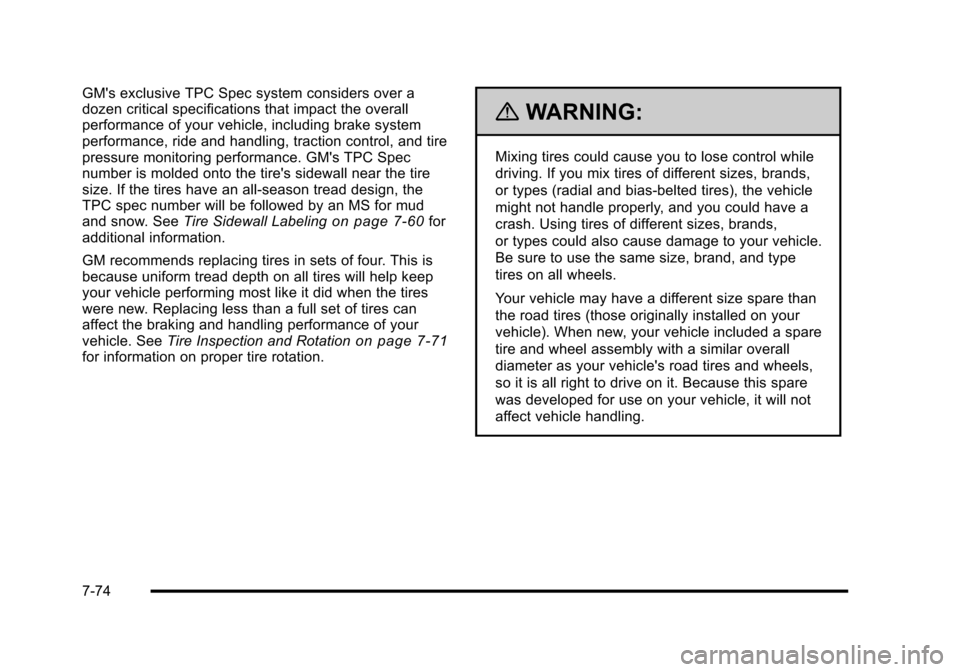
GM's exclusive TPC Spec system considers over adozen critical specifications that impact the overallperformance of your vehicle, including brake systemperformance, ride and handling, traction control, and tirepressure monitoring performance. GM's TPC Specnumber is molded onto the tire's sidewall near the tiresize. If the tires have an all!season tread design, theTPC spec number will be followed by an MS for mudand snow. SeeTire Sidewall Labelingon page 7!60foradditional information.
GM recommends replacing tires in sets of four. This isbecause uniform tread depth on all tires will help keepyour vehicle performing most like it did when the tireswere new. Replacing less than a full set of tires canaffect the braking and handling performance of yourvehicle. SeeTire Inspection and Rotationon page 7!71for information on proper tire rotation.
{WARNING:
Mixing tires could cause you to lose control while
driving. If you mix tires of different sizes, brands,
or types (radial and bias-belted tires), the vehicle
might not handle properly, and you could have a
crash. Using tires of different sizes, brands,
or types could also cause damage to your vehicle.
Be sure to use the same size, brand, and type
tires on all wheels.
Your vehicle may have a different size spare than
the road tires (those originally installed on your
vehicle). When new, your vehicle included a spare
tire and wheel assembly with a similar overall
diameter as your vehicle's road tires and wheels,
so it is all right to drive on it. Because this spare
was developed for use on your vehicle, it will not
affect vehicle handling.
7-74
Page 521 of 616
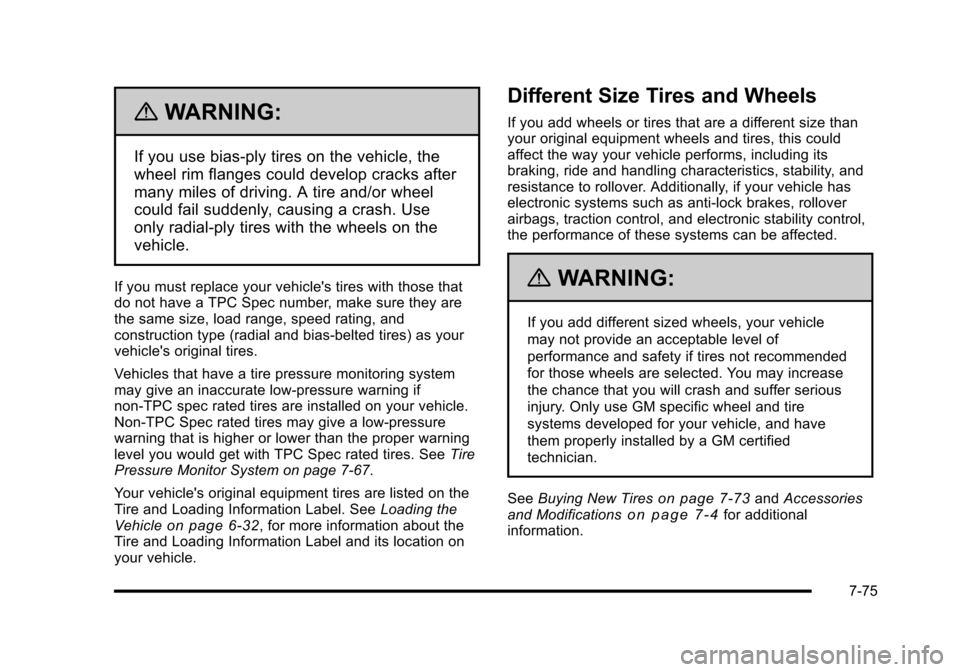
{WARNING:
If you use bias-ply tires on the vehicle, the
wheel rim flanges could develop cracks after
many miles of driving. A tire and/or wheel
could fail suddenly, causing a crash. Use
only radial-ply tires with the wheels on the
vehicle.
If you must replace your vehicle's tires with those thatdo not have a TPC Spec number, make sure they arethe same size, load range, speed rating, andconstruction type (radial and bias!belted tires) as yourvehicle's original tires.
Vehicles that have a tire pressure monitoring systemmay give an inaccurate low!pressure warning ifnon!TPC spec rated tires are installed on your vehicle.Non!TPC Spec rated tires may give a low!pressurewarning that is higher or lower than the proper warninglevel you would get with TPC Spec rated tires. SeeTirePressure Monitor System on page 7!67.
Your vehicle's original equipment tires are listed on theTire and Loading Information Label. SeeLoading theVehicleon page 6!32, for more information about theTire and Loading Information Label and its location onyour vehicle.
Different Size Tires and Wheels
If you add wheels or tires that are a different size thanyour original equipment wheels and tires, this couldaffect the way your vehicle performs, including itsbraking, ride and handling characteristics, stability, andresistance to rollover. Additionally, if your vehicle haselectronic systems such as anti!lock brakes, rolloverairbags, traction control, and electronic stability control,the performance of these systems can be affected.
{WARNING:
If you add different sized wheels, your vehicle
may not provide an acceptable level of
performance and safety if tires not recommended
for those wheels are selected. You may increase
the chance that you will crash and suffer serious
injury. Only use GM specific wheel and tire
systems developed for your vehicle, and have
them properly installed by a GM certified
technician.
SeeBuying New Tireson page 7!73andAccessoriesand Modificationso n p a g e 7!4for additionalinformation.
7-75
Page 525 of 616

WARNING: (Continued)
vehicle and tire size combination and road
conditions. Follow that manufacturer's
instructions. To help avoid damage to the vehicle,
drive slowly, re!adjust or remove the device if it is
contacting the vehicle, and do not spin the
wheels. If you do find traction devices that will fit,
install them on the rear tires.
If a Tire Goes Flat
It is unusual for a tire to blowout while you are driving,especially if you maintain your vehicle's tires properly.If air goes out of a tire, it is much more likely to leak outslowly. But if you should ever have a blowout, here area few tips about what to expect and what to do:
If a front tire fails, the flat tire creates a drag that pullsthe vehicle toward that side. Take your foot off theaccelerator pedal and grip the steering wheel firmly.Steer to maintain lane position, and then gently braketo a stop well out of the traffic lane.
A rear blowout, particularly on a curve, acts much like askid and may require the same correction you woulduse in a skid. In any rear blowout remove your foot fromthe accelerator pedal. Get the vehicle under control bysteering the way you want the vehicle to go. It may bevery bumpy and noisy, but you can still steer. Gentlybrake to a stop, well off the road if possible.
{WARNING:
Lifting a vehicle and getting under it to do
maintenance or repairs is dangerous without the
appropriate safety equipment and training. If a
jack is provided with the vehicle, it is designed
only for changing a flat tire. If it is used for
anything else, you or others could be badly
injured or killed if the vehicle slips off the jack.
If a jack is provided with the vehicle, only use
it for changing a flat tire.
If a tire goes flat, the next part shows how to use thejacking equipment to change a flat tire safely.
7-79
Page 544 of 616

Spare Tire
Your vehicle, when new, had a fully-inflated spare tire.A spare tire may lose air over time, so check its inflationpressure regularly. SeeInflation - Tire Pressureonpage 7!65andLoading the Vehicleon page 6!32forinformation regarding proper tire inflation and loadingyour vehicle. For instruction on how to remove, install orstore a spare tire, seeRemoving the Flat Tire andInstalling the Spare Tireon page 7!86andStoring aFlat or Spare Tire and Tools on page 7!94.
After installing the spare tire on your vehicle, you shouldstop as soon as possible and make sure the spare iscorrectly inflated. The spare tire is made to perform wellat speeds up to 70 mph (112 km/h) at the recommendedinflation pressure, so you can finish your trip.
Have the damaged or flat road tire repaired or replacedas soon as you can and installed back onto yourvehicle. This way, a spare tire will be available in caseyou need it again. Do not mix tires and wheels ofdifferent sizes, because they will not fit. Keep yourspare tire and its wheel together.
Appearance Care
Interior Cleaning
The vehicle's interior will continue to look its best if it iscleaned often. Although not always visible, dust and dirtcan accumulate on the upholstery. Dirt can damagecarpet, fabric, leather, and plastic surfaces. Regularvacuuming is recommended to remove particles fromthe upholstery. It is important to keep the upholsteryfrom becoming and remaining heavily soiled. Soilsshould be removed as quickly as possible. Thevehicle's interior may experience extremes of heat thatcould cause stains to set rapidly.
Lighter colored interiors may require more frequentcleaning. Use care because newspapers and garmentsthat transfer color to home furnishings may also transfercolor to the vehicle's interior.
When cleaning the vehicle's interior, only use cleanersspecifically designed for the surfaces being cleaned.Permanent damage may result from using cleaners onsurfaces for which they were not intended. Use glasscleaner only on glass. Remove any accidentalover-spray from other surfaces immediately. To preventover-spray, apply cleaner directly to the cleaning cloth.
7-98
Page 612 of 616

Sunroof . . . . . . . . . . . . . . . . . . . . . . . . . . . . . . . . . . . . . . . . . . . . 3-66
Symbols . . . . . . . . . . . . . . . . . . . . . . . . . . . . . . . . . . . . . . . . . . . 5-17
System
Roof Rack . . . . . . . . . . . . . . . . . . . . . . . . . . . . . . . . . . . . . . . . 3-64
System Needs Service, If . . . . . . . . . . . . . . . . . . . . . . . . . . 5-59
T
Tachometer . . . . . . . . . . . . . . . . . . . . . . . . . . . . . . . . . . . . . . . . 4-29
Text Telephone (TTY) Users . . . . . . . . . . . . . . . . . . . . . . . . .9-6
Theft-Deterrent Feature . . . . . . . . . . . . . . . . . . . . . . . . . . . 4-105
Theft-Deterrent Systems . . . . . . . . . . . . . . . . . . . . . . . . . . . 3-22
Content Theft-Deterrent . . . . . . . . . . . . . . . . . . . . . . . . . . 3-22
PASS-Key®III+ Electronic Immobilizer . . . . . . . . . . . . 3-24
PASS-Key®III+ Electronic Immobilizer
Operation . . . . . . . . . . . . . . . . . . . . . . . . . . . . . . . . . . . . . . . 3-24
Third Row Seat . . . . . . . . . . . . . . . . . . . . . . . . . . . . . . . . . . . . 2-21
Throttle, Adjustable . . . . . . . . . . . . . . . . . . . . . . . . . . . . . . . . 3-30
Tilt Wheel . . . . . . . . . . . . . . . . . . . . . . . . . . . . . . . . . . . . . . . . . . . .4-3
Tires . . . . . . . . . . . . . . . . . . . . . . . . . . . . . . . . . . . . . . . . . . . . . . . 7-58
Aluminum or Chrome-Plated Wheels,
Cleaning . . . . . . . . . . . . . . . . . . . . . . . . . . . . . . . . . . . . . . .7-104
Buying New Tires . . . . . . . . . . . . . . . . . . . . . . . . . . . . . . . . . 7-73
Chains . . . . . . . . . . . . . . . . . . . . . . . . . . . . . . . . . . . . . . . . . . . . 7-78
Tires (cont.)
Changing a Flat Tire . . . . . . . . . . . . . . . . . . . . . . . . . . . . . . 7-80
Cleaning . . . . . . . . . . . . . . . . . . . . . . . . . . . . . . . . . . . . . . . . .7-105
Different Size . . . . . . . . . . . . . . . . . . . . . . . . . . . . . . . . . . . . . 7-75
High-Speed Operation . . . . . . . . . . . . . . . . . . . . . . . . . . . . 7-66
If a Tire Goes Flat . . . . . . . . . . . . . . . . . . . . . . . . . . . . . . . . 7-79
Inflation - Tire Pressure . . . . . . . . . . . . . . . . . . . . . . . . . . . 7-65
Inspection and Rotation . . . . . . . . . . . . . . . . . . . . . . . . . . 7-71
Installing the Spare Tire . . . . . . . . . . . . . . . . . . . . . . . . . . 7-86
Pressure Light . . . . . . . . . . . . . . . . . . . . . . . . . . . . . . . . . . . . 4-35
Pressure Monitor Operation . . . . . . . . . . . . . . . . . . . . . . 7-68
Pressure Monitor System . . . . . . . . . . . . . . . . . . . . . . . . . 7-67
Removing the Flat Tire . . . . . . . . . . . . . . . . . . . . . . . . . . . 7-86
Removing the Spare Tire and Tools . . . . . . . . . . . . . . . 7-81
Secondary Latch System . . . . . . . . . . . . . . . . . . . . . . . . . 7-91
Sidewall Labeling . . . . . . . . . . . . . . . . . . . . . . . . . . . . . . . . . 7-60
Spare Tire . . . . . . . . . . . . . . . . . . . . . . . . . . . . . . . . . . . . . . . . 7-98
Storing a Flat or Spare Tire and Tools . . . . . . . . . . . . 7-94
Terminology and Definitions . . . . . . . . . . . . . . . . . . . . . . 7-62
Uniform Tire Quality Grading . . . . . . . . . . . . . . . . . . . . . 7-76
Wheel Alignment and Tire Balance . . . . . . . . . . . . . . . 7-77
Wheel Replacement . . . . . . . . . . . . . . . . . . . . . . . . . . . . . . 7-77
When It Is Time for New Tires . . . . . . . . . . . . . . . . . . . . 7-73
i - 14
Page 614 of 616

W
Warning Lights, Gages, and Indicators . . . . . . . . . . . . 4-27
Warnings
DIC Warnings and Messages . . . . . . . . . . . . . . . . . . . . . 4-48
Hazard Flashers . . . . . . . . . . . . . . . . . . . . . . . . . . . . . . . . . . . 4-3
Safety and Symbols . . . . . . . . . . . . . . . . . . . . . . . . . . . . . . . . . iv
Wheels
Alignment and Tire Balance . . . . . . . . . . . . . . . . . . . . . . 7-77
Different Size . . . . . . . . . . . . . . . . . . . . . . . . . . . . . . . . . . . . . 7-75
Replacement . . . . . . . . . . . . . . . . . . . . . . . . . . . . . . . . . . . . . 7-77
When It Is Time for New Tires . . . . . . . . . . . . . . . . . . . . . 7-73
Where to Put the Child Restraint . . . . . . . . . . . . . . . . . . . 2-57
Windows . . . . . . . . . . . . . . . . . . . . . . . . . . . . . . . . . . . . . . . . . . 3-18
Power . . . . . . . . . . . . . . . . . . . . . . . . . . . . . . . . . . . . . . . . . . . . 3-19
Windshield
Backglass, and Wiper Blades, Cleaning . . . . . . . . .7-104
Washer . . . . . . . . . . . . . . . . . . . . . . . . . . . . . . . . . . . . . . . . . . . . 4-7
Washer Fluid . . . . . . . . . . . . . . . . . . . . . . . . . . . . . . . . . . . . . 7-39
Wiper Blade Replacement . . . . . . . . . . . . . . . . . . . . . . . . 7-57
Wiper Fuses . . . . . . . . . . . . . . . . . . . . . . . . . . . . . . . . . . . . .7-108
Wipers . . . . . . . . . . . . . . . . . . . . . . . . . . . . . . . . . . . . . . . . . . . . . 4-6
Winter Driving . . . . . . . . . . . . . . . . . . . . . . . . . . . . . . . . . . . . . 6-28
Wipers
Rear Washer . . . . . . . . . . . . . . . . . . . . . . . . . . . . . . . . . . . . . . 4-7
X
XM™Satellite Radio
Antenna . . . . . . . . . . . . . . . . . . . . . . . . . . . . . . . . . . . . . . . . .4-108
i - 16